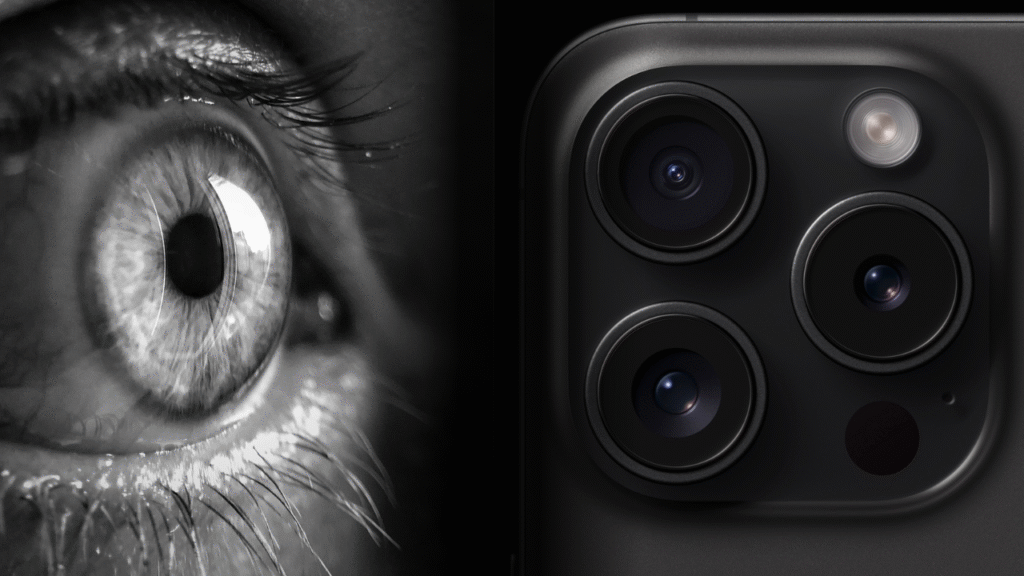Apple’s patented stacked sensor innovation hints at a future where smartphone cameras can capture light and shadow with unprecedented naturalism—moving closer to what the human eye perceives. While the concept is still under patent protection and may not be commercialized immediately, the technology signals a major leap forward in image capture, HDR capability, and sensor-level intelligence. It’s a glimpse into a future where phones may come closer than ever to mimicking human vision.

What the Patent Shows
Stacked Sensor Design
The patented sensor combines two silicon layers:
Sensor die: the top layer, responsible for capturing light.
Logic die: the bottom layer, handling processing and noise control.
This architecture enables placing more processing circuitry directly underneath the pixel layer, saving space and increasing power efficiency over conventional designs.
Up to 20 Stops of Dynamic Range
The goal of the design is to produce a dynamic range of 20 EV (exposure stops), which is equivalent to a contrast ratio of more than 1,000,000:1 in a single picture. It’s a huge step forward from today’s smartphone cameras, which usually capture between 10 and 13 stops, and it even outperforms high-end cinema cameras like the ARRI ALEXA 35.
This sensor would give Apple devices roughly the same contrast sensitivity as the human eye, which is thought to be able to distinguish between 20 and 30 stops.
Advanced Pixel-Level Light and Noise Control
The sensor in Apple devices makes use of the Lateral Overflow Integration Capacitor (LOFIC) technique, which enables each pixel to simultaneously capture various light levels, making it perfect for capturing scenes with both strong highlights and deep shadows without sacrificing detail.
Furthermore, each pixel includes a small memory circuit that is able to identify and eliminate heat-induced electronic noise in real time, resulting in a cleaner capture even before any software processing.
Why It Matters
Cinematic-level clarity: With this level of dynamic range, future Apple devices could produce images rivaling high-end filmmaking cameras.
True-to-life visuals: Capturing both deep shadows and bright highlights in one frame would narrow the gap between what the camera sees and how your eyes perceive a scene in real life.
Better in difficult lighting: Scenario examples include interior shots with bright windows, nighttime photography with mixed lighting, or outdoor scenes at dawn or dusk—all with retained detail.
Noise-free low-light performance: Pixel-level noise suppression could make dark scenes notably cleaner, reducing grain and artifacting.
What This Isn’t
Currently not in use: This is a patent application, not a product that has been sent. Apple frequently supports patents that might never make it into commercial products.
Not about resolution: While impressive, the patent addresses range and contrast, not image resolution or pixel count. Human perception of detail involves temporal adaptation, foveated vision, and complex brain processing beyond raw pixel specs.
Still limited by optics and processing: Other factors—like lens quality, image stabilization, and computational image processing—also influence final photo quality.
If Apple brings this sensor to market, expect:
Upcoming iPhone generations (beyond the announced iPhone 17) to feature major HDR improvements.
Better low-light and HDR video performance, without reliance on heavy computational tricks.
Potential integration into AR/VR devices like Vision Pro, where capturing a wide range of light is critical for realism.
| Feature | What Apple is Proposing | Human Eye Reference |
|---|---|---|
| Dynamic Range | Up to 20 stops (~1,000,000:1) | ~20–30 stops depending on adaptive eye function |
| Pixel Light Management | LOFIC multi-exposure per pixel | Continuous aperture and retinal adaptation |
| Noise Reduction | Per-pixel memory circuit for real-time cancellation | Brain filters visual noise over time |
| Current Phone Cameras | ~10–13 stops | N/A |


